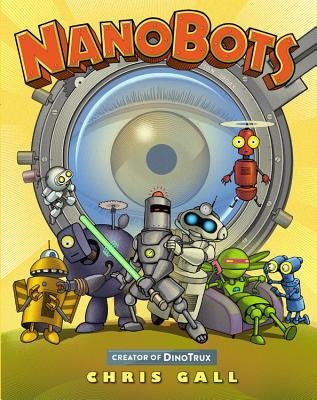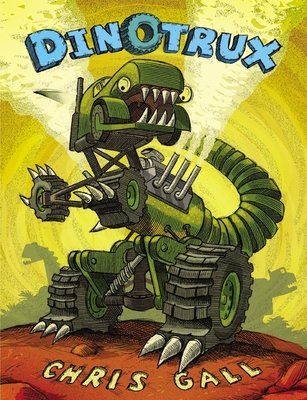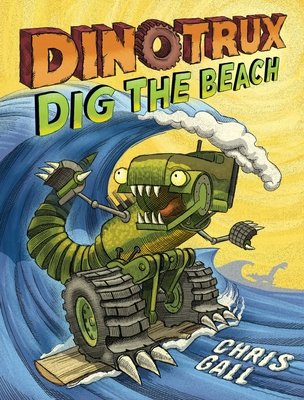From Dinotrux to NanoBots:
How Simple Observations Fuel Imagination
by Chris Gall
Some call it being curious, or having an interest, but I say I’ve always been a noticer.
As a child, I was obsessed with the world around me — the rocks, plants, people, and machines. I noticed everything. When I was nine I lived for a time in Switzerland, with a railway practically running through my backyard. I noticed some trains went by at predictable times, so I made a catalog with drawings and timetables of every train that passed. Later, when I noticed a discarded water heater that looked like the body of a rocket, I drew up plans to build one.
My attention to detail was a mixed blessing as a child. Sometimes I noticed things I didn’t want to notice, like the fact that my Christmas presents from Santa were stamped in very small print: “Made in Japan.” Once I got a pummeling at school from a larger boy when I innocently asked him, “Do those clouds seem melancholy to you?” Not everybody, it seemed, was a noticer.
Luckily, I was shaped by other noticers. I was the eldest child of an engineer and scientist father and a mother with a degree in art history. Plus, my grandmother was a librarian. So, my father enticed me with his cool laboratory equipment, my mother dragged me through innumerable art museums (though, of course, it was years before I could appreciate it), and my grandmother made sure I read 15 books per summer — the absolute minimum acceptable.
My family was wise to help me find books that reflected my ever-growing interests. Reading brought those to life. For every new discovery I made — whether it was a planet, an animal, or a new dinosaur — there was a book that could teach me more about the topic. My summers soon became known mostly for sore elbows, the kind you only get from long hours reading on your bed.
As an adult, I was driving down a highway one day and came to a stop due to road construction. I wasn’t thinking about the annoyance of the delay; I was noticing what was outside my window. A group of large earth-moving trucks was working along the median. They were loud and smelly, their tires looked like animal skin, and every so often they let out a roar as their engines struggled with the dirt.
My imagination raced.
I thought of dinosaurs. No, not just dinosaurs, dinosaur trucks. Dinotrux. After some research, I began to notice all the similarities between various dinosaurs and trucks. A bulldozer’s blade looked like the headpiece of Triceratops. Dozeratops. The long-necked Brachiosaurus reminded me of a crane truck. Craneosaurus. And just like that, a new species — and new book series — was born.
In my latest book, NanoBots, a microscopic collection of superheroes helps mankind to make the world a better place. My inspiration arose, again, from reading and observation. Poring through scientific articles about the latest discoveries in nanotechnology, I instantly envisioned how the topic might be fascinating for children, who are small themselves after all.

I really only have one rule when it comes to writing books for children: I write the stories I would have wanted to read when I was a child. Luckily for me, I’m still connected to my youth; I have all the same interests now as I did when I was young. Though my wife often views me with wary concern, I still examine every plane in the sky, pick up unusual rocks from the ground, and will patiently wait at a train crossing, as close as I can get, until a mighty locomotive thunders by and shakes me to my bones.
Whether you call it curiosity, interest, or simply noticing, learning to sow the precious seed of imagination is a gift … and I’m thankful to my family for teaching it to me.
-
By the Author:
-
Chris Gall is the award-winning author and illustrator of Dinotrux, a Publishers Weekly Best Children’s Book which inspired a Netflix original TV series, and the other books in the series, including Dinotrux Dig the Beach and Revenge of the Dinotrux. His other picture books include NanoBots, Dog vs. Cat, Awesome Dawson, Substitute Creacher, and America the Beautiful, another Publisher’s Weekly Best Children’s Book. He lives in Tucson, Arizona.




